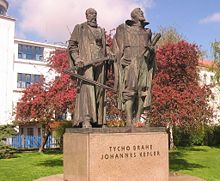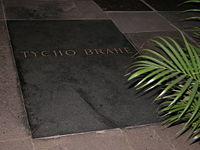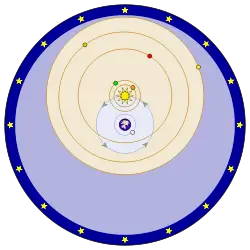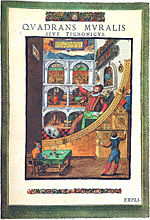Brahe, Tycho
Peter Duveen (talk | contribs) (→Death) |
Peter Duveen (talk | contribs) |
||
| Line 22: | Line 22: | ||
[[Image:Brahe kepler.jpg|thumb|220px|Monument of Tycho Brahe and [[Johannes Kepler]] in [[Prague]]]] | [[Image:Brahe kepler.jpg|thumb|220px|Monument of Tycho Brahe and [[Johannes Kepler]] in [[Prague]]]] | ||
| − | '''Tycho Brahe''', born '''Tyge Ottesen Brahe''' (December 14, 1546 – October 24, 1601), was a | + | '''Tycho Brahe''', born '''Tyge Ottesen Brahe''' (December 14, 1546 – October 24, 1601), was a Danish astronomer whose accurate measurements of the positions of the stars and planets established the basis for Johannes Kepler's laws of planetary motion. Brahe also developed a theory in which the earth served as the center of solar and planetary motion, while the planets other than earth circled the sun. |
| − | |||
| − | |||
| − | |||
| − | |||
==Life== | ==Life== | ||
Revision as of 23:57, 7 December 2007
- This article is about the astronomer.
| Tycho Ottesen Brahe | |
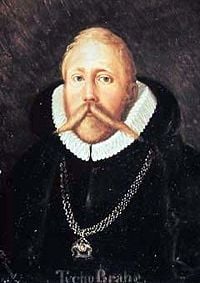 | |
| Born | December 14 1546 Knutstorp Castle, Denmark |
|---|---|
| Died | October 24 1601 (aged 54) Prague |
| Nationality | Danish |
| Education | private |
| Occupation | nobleman, astronomer |
| Spouse(s) | Kirsten Jørgensdatter |
| Children | 8 |
| Parents | Otte Brahe and Beate Bille |
Tycho Brahe, born Tyge Ottesen Brahe (December 14, 1546 – October 24, 1601), was a Danish astronomer whose accurate measurements of the positions of the stars and planets established the basis for Johannes Kepler's laws of planetary motion. Brahe also developed a theory in which the earth served as the center of solar and planetary motion, while the planets other than earth circled the sun.
Life
Early years
Tycho Brahe was born Tyge Ottesen Brahe (de Knutstorp), adopting the Latinised form Tycho around age fifteen (sometimes written Tÿcho). He is often misnamed Tycho de Brahe. He was born at his family's ancestral seat of Knutstorp Castle, Denmark to Otte Brahe and Beate Bille. His twin brother died before being baptized. (Tycho wrote a Latin ode (Wittendorf 1994, p. 68) to his dead twin which was printed as his first publication in 1572). He also had two sisters, one older (Kirstine Brahe) and one younger (Sophia Brahe). Otte Brahe, Tycho's father, was a nobleman and an important figure in the Danish King's court. His mother, Beate Bille, also came from an important family that had produced leading churchmen and politicians. In his youth he lived at Hvedborg Manor, Funen, Denmark with his uncle and attended Horne Church in nearby Horne.
Tycho later wrote that when he was around two, his uncle, Danish nobleman Jørgen Brahe, "... without the knowledge of my parents took me away with him while I was in my earliest youth." Tycho's father had promised to allow his uncle to adopt one of his children, but when Tycho was born, his parents lost heart and kept the child. A year or so later, upon the birth of a second son, Uncle Jorgen took the older boy to finally seal the bargain. <<<Ball, Robert S. 2004. Great astronomers. Fairfield, IA: 1st World Library Literary Society. 38. ISBN 1421814935.>>>Apparently this did not lead to any disputes nor did his parents attempt to get him back. Tycho lived with his childless uncle and aunt, Jørgen Brahe and Inger Oxe, in the Tostrup Castle until he was six years old. Around 1552 his uncle was given the command of Vordingborg Castle to which they moved, and where Tycho began a Latin education until he was 12 years old.
On April 19, 1559, Tycho began his studies at the University of Copenhagen. There, following the wishes of his uncle, he studied law but also studied a variety of other subjects and became interested in astronomy. It was, however, the eclipse which occurred on August 21, 1560, particularly the fact that it had been predicted, that so impressed him that he began to make his own studies of astronomy helped by some of the professors. He purchased an ephemeris and books such as Sacrobosco's Tractatus de Sphaera, Apianus's Cosmographia seu descriptio totius orbis and Regiomontanus's De triangulis omnimodis. During this time he especially relied on a classic work of Ptolemy on astronomy, and the book survives to the present day along with the notes that Tycho had scribbled in its margins.<<<Ball 39>>>
In 1562, Tycho's uncle sent him with a tutor to the University of Leipzig to finish his education, the hope being that he would focus on studies that would prepare him for a career in law of statesmanship. Tycho, however, made it clear by his actions, both overt and covert, that astronomy, and its related discipline, astrology, were the only pursuits worthy of his time. Realizing the deficiencies in the state of astronomy at the time, he made instruments by hand that would enable him to more accurately chart the heavens.
I've studied all available charts of the planets and stars and none of them match the others. There are just as many measurements and methods as there are astronomers and all of them disagree. What's needed is a long term project with the aim of mapping the heavens conducted from a single location over a period of several years.—Tycho Brahe, 1563 (age 17).
Tycho was able to improve and enlarge the existing instruments, and construct entirely new ones. Tycho's naked eye measurements of planetary parallax were accurate to the arcminute. His sister, Sophia, assisted Tycho in many of his measurements. These jealously guarded measurements were "usurped" by Kepler following Tycho's death.[1] Tycho was the last major astronomer to work without the aid of a telescope, soon to be turned toward the sky by Galileo.
Tycho's nose
In 1865, Tycho's uncle died of pneumonia after rescuing Frederick II of Denmark from drowning, and Tycho returned home to claim his inheritance. He was not, however, greeted with open arms by his relations and colleagues in Denmark, who were critical of his chosen vocation. This misunderstanding led Tycho to seek a more congenial environment outside of his native land, and he embarked on a tour of the continent. <<<Brewster, David. 1830. Brahe, Tycho. The Edinburgh encyclopaedia. Edinburgh: W. Blackwood [and others]. 400.>>> It was at the beginning of this journey that Tycho lost part of his nose in a duel with rapiers with Manderup Parsbjerg, a fellow Danish nobleman. This occurred in the Christmas season of 1566, after a fair amount of drinking, while the just turned 20-year-old Tycho had stopped at the University of Rostock in Germany. Attending a dance at a professor's house, he quarreled with Parsbjerg,it is said, over a matter of geometry. A subsequent duel (in the dark) resulted in Tycho losing the bridge of his nose. A consequence of this was that Tycho developed an interest in medicine and alchemy. For the rest of his life, he was said to have worn a replacement made of silver and gold blended into a flesh tone, and used an adhesive balm to keep it attached. However, in 1901 Tycho's tomb was opened and his remains were examined by medical experts. The nasal opening of the skull was rimmed with green, a sign of exposure to copper, not silver or gold. Some historians have speculated that he wore a number of different prosthetics for different occasions, noting that a copper nose would have been more comfortable and less heavy than a precious metal one.
Tycho went on to Augsburg, where he asssisted the city's burgomaster, Peter Hainzell, in the construction of an observatory that included a 19-foot quadrant, an instrument used to measure the position of the stars. He continued to travel, visiting a number of observatories in Germany, Switzerland and Italy. <<<Brewster 1830, 400.>>> At the end of 1570 he was informed about his father's ill health, so he returned to Knudstrup, where his father died on May 9 1571. Soon after, his maternal uncle Steen Bille helped him build an observatory and alchemical laboratory at Herrevad Abbey.
Family life
In 1572, in Knudstrup, Tycho fell in love with Kirsten Jørgensdatter, a commoner whose father, Pastor Jorgen Hansen, was the Lutheran clergyman of Knudstrup's village church. Under Danish law, when a nobleman and a common woman lived together openly as husband and wife, and she wore the keys to the household at her belt like any true wife, their alliance became a binding morganatic marriage after three years. The husband retained his noble status and privileges; the wife remained a commoner. Their children were legitimate in the eyes of the law, but they were commoners like their mother and could not inherit their father's name, coat of arms, or land property. (Skautrup 1941, pp. 24-5)
Kirsten Jørgensdatter gave birth to their first daughter, Kirstine (named after Tycho's late sister who died at 13) on October 12, 1573. Together they had eight children, six of whom lived to adulthood. In 1574, they moved to Copenhagen where their daughter Magdalene was born. Kirsten and Tycho lived together for almost thirty years until Tycho's death.
The nova of 1572
In the very same year as his marriage, Tycho observed a bright object in the sky in the constellation of Cassiopia that had not been there before. He determined its position, and attempted to estimate its distance by measuring the change in its position relative to the surrounding stars as the earth made a half rotation. After finding that there was no change in the star's relative position, he concluded that the star was of a distance far greater than the diameter of the earth. Tycho made other observations about the star, including its brightness, color, and the change in its appearance over time. He published his observations in a work circulated among his friends and associates in 1573.
King Frederick I had heard about the fame Tycho was gradually acquiring through his astronomical and astrological pursuits, and invited him to lecture in Copenhagen. Yet even though the monarch had raised his status, Tycho was still dissatisfied with the reception his activities attracted, and he hoped to find a more amenable environment in Switzerland. In 1576, he was in the process of arranging for his family to move to Basel, when he received a message from Frederick granting him a generous annual stipend and promises of assistance in the construction of a new observatory in Hven, an offer Tycho could not refuse. Construction of the observatory, which he named Uraniburg, commenced in the summer, and the elaborately decorated facilities were soon in operation. From this new headquarters, which included apartments for the entertainment of dignitaries as well as a separate observatory for his students, Tycho received royalty from his home country and from around the world, including an eight-day visit from King James VI of Scotland. <<<Brewster 401>>>. During this period, which was to last 21 years, Tycho made important observations of the planet Mars and of the moon, He was able to uncover some important irregularities in the Moon's motion that became the focus of attention for hundreds of years by later researchers who attempted to apply the gravitational theory of Isaac Newton to account for these.
After the death of Frederick, and the succcession of his son, Christian IV, Tycho gradually fell out of the graces of the Danish monarchy, perhaps at least partly due to the jealousy generated by the international attention the astronomer and his observatory garnered. Tycho is said to have had an impetuous and argumentative disposition, along with a penchant for irony and cynicism in his humor, and these in combination had the gradual effect of undermining his base of support. As a result, his stipend was taken from him, and the lands associated with Uraniborg were also withdrawn, forcing him to find another location to conduct his astronomical research. He removed to Copenhagen with his family around 1597, and by 1598 had situated himself in the vicinity of Rostock, where he was greeted by the astronomer Henry Rantzau. In 1599, he was received by Emperor Rudolph II, to which he had dedicated his latest work on the position of the planets. Rudolph erected an obervatory for Tycho in the vicinity of Prague, and granted the astronomer a generous pension. In spite of the graciousness of his new patron, however, Tycho often longed for the friendships of his abandoned homeland, and grew increasingly suspicious and argumentative. His health declined rapidly toward the end of his life. Still, in 1600, he would make what proved to be a monumental decision of inviting Johannes Kepler to join him. Kepler had already come to the attention of Tycho through some of his early published works, which Tycho had provided a detailed criticism of. In fact, Tycho intimated that Kepler's theories had led him to increased the accuracy of his measurements. An exchange of letters resulted in Tycho's very forthcoming invitation. "Come not as a stranger, but as a very welcome friend; come and share in my observations with such instruments as I have with me, and as a dearly beloved associate."
For several months Kepler joined Tycho, who promised to intervene with the emperior on his behalf to establish a paid position for him at the observatory. But he left for a time, leaving his wife and children in Tycho's household. In the meantime, he ran out of money, and asked Tycho to assist him, the later obliging without remonstrance. Kepler then left Prague for a second time, and sent an angry letter of accusation against his his patron, apparently believing that he had not adequately helped his family,but perhaps more importantly, because he believed that Tycho had not shared data on the observations he had collected on Mars. This data was the very reason Kepler had sought out Tycho, as it bore directly on Kepler's theory of planetary motion.
Tycho had one of his assistants respond with a concilliatory letter, to which Kepler finally responded in tones of regret and repentance. The two were finally reconciled in 1601. At that time, Tycho presented Kepler to the emperor, who bestowed on the young astronomer the title of Imperial Mathematician, accompanied by an obligation to further assist Tycho in his obervations and research.
Kepler focusd on Tycho's observations on Mars, the compilation of which, it was agreed, would be named the Rudolphine Tables after the emperor. Work on Tycho's stellar observations was left to Longomontanus, another of Tycho's assistants. Longomontanus, however, abandoned Tycho for a teaching position in Denmark, and it was soon after this that Tycho himself began to show the signs of wear to which he was subjected by the stringent schedule he subjected himself to.
Death
It was during a visit to a nobleman that Tycho suffered an attack described as a retention of urine. In the week that followed, he suffered unimaginably from the condition that had affected his body. While the immediate symptoms of this condition finally abated, Tycho was left in a considerably weakened state. On the day of his death, he gave final instructions to his family and staff. He died on October 24 1601, eleven days after first being stricken. <<<Brewster, David. 1841. The martyrs of science; or, The lives of Galileo, Tycho Brahe, and Kepler. New York: Harper & Brothers. 181.>>> Toward the end of his illness he is said to have told Kepler "Ne frustra vixisse videar!," "Let me not seem to have lived in vain”.[2][3] For hundreds of years, the general belief was that he had strained his bladder. It had been said that to leave the banquet before it concluded would be the height of bad manners, and so he remained, and that his bladder, stretched to its limit, developed an infection which he later died of. This theory was supported by Kepler's first-hand account.
Recent investigations have suggested that Tycho did not die from urinary problems but instead from mercury poisoning: extremely toxic levels of it have been found in his hair and hair-roots. Tycho may have poisoned himself by imbibing some medicine containing unintentional mercuric chloride impurities, or may have been poisoned.[4] According to a 2005 book by Joshua and Anne-Lee Gilder, there is substantial circumstantial evidence that Kepler murdered Brahe; they argue that Kepler had the means, motive, and opportunity, and stole Tycho's data on his death.[5] According to the Gilders, they find it "unlikely"[5] Tycho could have poisoned himself since he was an alchemist known to be familiar with the toxicity of different mercury compounds. At the same time, the early deaths of other scientists such as Scheele have often been attributed to the very fact that they were involved in chemical investigations and that their experiments continually exposed them to hazardous chemicals.
Kepler inherited Tycho's position after Tycho's death, and completed the Rudolphine Tables in 1627. He attempted to publish Tycho's work almost immediately after the astronomer's death, but the family confiscated Tycho's papers and published the results themselves. Tycho objected, as he insisted that some of the notes in the margins that had been his were published along with the work of Tycho.
Tycho Brahe's body is currently interred in a tomb in the Church of Our Lady in front of Týn near Old Town Square near the Astronomical Clock in Prague.
Career: observing the heavens
Supernova
On November 11, 1572, Tycho observed (from Herrevad Abbey) a very bright star which unexpectedly appeared in the constellation Cassiopeia, now named SN 1572. Since it had been maintained since antiquity that the world beyond the orbit of the moon, i.e. that of the fixed stars, was eternal and unchangeable (a fundamental axiom of the Aristotelian world view: celestial immutability), other observers held that the phenomenon was something in the Earth's atmosphere. Tycho, however, observed that the parallax of the object did not change from night to night, suggesting that the object was far away. Tycho argued that a nearby object should appear to shift its position with respect to the background. He published a small book, De Stella Nova (1573), thereby coining the term nova for a "new" star (we now know that Tycho's star in Cassiopeia was a supernova 7500 light years from earth). This discovery was decisive for his choice of astronomy as a profession. Tycho was strongly critical of those who dismissed the implications of the astronomical appearance, writing in the preface to De Stella Nova: "O crassa ingenia. O caecos coeli spectatores" ("Oh thick wits. Oh blind watchers of the sky").
Heliocentrism
Kepler tried, but was unable, to persuade Tycho to adopt the heliocentric model of the solar system. Tycho believed in a modified geocentric model known as the Tychonic system, for the same reasons that he argued that the supernova of 1572 was not near the Earth. He argued that if the Earth were in motion, then nearby stars should appear to shift their positions with respect to background stars. In fact, this effect of parallax does exist; but it could not be observed with the naked eye, or even with the telescopes of the next two hundred years, because even the nearest stars are much more distant than most astronomers of the time believed possible. The Tychonic system is very similar to the Copernican one, except that it has a static earth instead of a static sun.
In the years following Galileo's observation of the phases of Venus in 1610, which made the Ptolemaic system intractable, the Tychonic system became the major competitor with Copernicanism, and was adopted by the Roman Catholic Church for many years as its official astronomical conception of the universe.
Uraniborg, Stjerneborg, and Benátky nad Jizerou
King Frederick II of Denmark and Norway, impressed with Tycho's 1572 observations, financed the construction of two observatories for Tycho on the island of Hven in Oresund. These were Uraniborg and Stjerneborg. Uraniborg also had a laboratory for his alchemical experiments.
Because Tycho disagreed with Christian IV, the new king of his country, he left Hven in 1597 and moved to Prague in 1599. Sponsored by Rudolf II, the Holy Roman Emperor, he built a new observatory in a castle in Benátky nad Jizerou, 50 km from Prague, and he worked there for one year. The emperor then had him move back to Prague, where he stayed until his death. Besides the emperor himself, he was also financially supported by several nobles, including Oldrich Desiderius Pruskowsky von Pruskow, to whom he dedicated his famous volume, the "Mechanica."
In return for their support, Tycho's duties included preparing astrological charts and predictions for his patrons on events such as births, weather forecasting, and providing astrological interpretations of significant astronomical events such as the comet of 1577 and the supernova of 1572.
Astronomy
Tycho was the preeminent observational astronomer of the pre-telescopic period, and his observations of stellar and planetary positions achieved unparalleled accuracy for their time. For example, Tycho measured Earth's axial tilt as 23 degrees and 31.5 minutes, which he claimed to be more accurate than Copernicus by 3.5 minutes. After his death, his records of the motion of the planet Mars enabled Kepler to discover the laws of planetary motion, which provided powerful support for the Copernican heliocentric theory of the solar system.
Tycho himself was not a Copernican, but proposed a system in which the Sun orbited the Earth while the other planets orbited the Sun. His system provided a safe position for astronomers who were dissatisfied with older models but were reluctant to accept the Earth's motion. It gained a considerable following after 1616 when Rome decided officially that the heliocentric model was contrary to both philosophy and Scripture, and could be discussed only as a computational convenience that had no connection to fact. His system also offered a major innovation: while both the geocentric model and the heliocentric model as set forth by Copernicus relied on the idea of transparent rotating crystalline spheres to carry the planets in their orbits, Tycho eliminated the spheres entirely.
He was aware that a star observed near the horizon appears with a greater altitude than the real one, due to atmospheric refraction, and he worked out tables for the correction of this source of error.
To perform the huge number of products needed to produce much of his astronomical data, Tycho relied heavily on the then-new technique of prosthaphaeresis, an algorithm for approximating products based on trigonometric identities that predated logarithms.
Astrology
Like the fifteenth-century astronomer Regiomontanus, Tycho Brahe appears to have accepted astrological prognostications on the principle that the heavenly bodies undoubtedly influenced (yet did not determine) terrestrial events, but expressed skepticism about the multiplicity of interpretative schemes, and increasingly preferred to work on establishing a sound mathematical astronomy. Two early tracts, one entitled Against Astrologers for Astrology, and one on a new method of dividing the sky into astrological houses, were never published and are now lost.
Tycho also worked in the area of weather prediction, produced astrological interpretations of the supernova of 1572 and the comet of 1577, and furnished his patrons Frederick II and Rudolph II with nativities and other predictions (thereby strengthening the ties between patron and client by demonstrating value). An astrological world view was fundamental to Tycho's entire philosophy of nature. His interest in alchemy, particularly the medical alchemy associated with Paracelsus, was almost as long-standing as his study of astrology and astronomy simultaneously, and Uraniborg was constructed as both observatory and laboratory.
In an introductory oration to the course of lectures he gave in Copenhagen in 1574, Tycho defended astrology on the grounds of correspondences between the heavenly bodies, terrestrial substances (metals, stones etc.) and bodily organs (medical astrology). He was later to emphasise the importance of studying alchemy and astrology together with a pair of emblems bearing the mottoes: Despiciendo suspicio ("By looking down I see upward") and Suspiciendo despicio ("By looking up I see downward"). As several scholars have now argued, Tycho's commitment to a relationship between macrocosm and microcosm even played a role in his rejection of Copernicanism and his construction of a third world-system.
Named after Tycho
Geography
Things
- Tycho Brahe Planetarium in Copenhagen, Denmark.
- M/F Tycho Brahe, a Scandlines ferry connecting Helsingør in Denmark and Helsingborg in Sweden
- Tyho Braheskolan, a science college in Helsingborg
- US Naval Observatory Time Service Department web site tycho.usno.navy.mil
Literature
- Tycho Brahes Weg zu Gott (Tycho Brahe's Path to God) by Max Brod, 1916
See also
- Johannes Kepler
- Nicolaus Copernicus
- Ptolemy
- Scientific Revolution
Notes
- ↑ Hawking, Stephen. 2004. The Illustrated on the Shoulders of Giants: The Great Works of Physics and Astronomy. Philadelphia, PA: Running Press. ISBN 0762418982.
- ↑ Gassendi, Pierre. 1654. Tycho Brahe.
- ↑ Goodstein, David L. and Judith R. Goodstein. 1999. Feynman's Lost Lecture: The Motion of Planets Around the Sun. New York, NY: W.W. Norton & Co. ISBN 0393039188.
- ↑ How did Tycho Brahe die?. tychobrahe.com. Retrieved November 17, 2007.
- ↑ 5.0 5.1 Gilder, Joshua and Anne-Lee Gilder. 2004. Heavenly Intrigue: Johannes Kepler, Tycho Brahe, and the Murder Behind One of History's Greatest Scientific Discoveries. New York, NY: Doubleday. ISBN 0385508441.
ReferencesISBN links support NWE through referral fees
- Brahe, Tycho, John Dreyer ed. 1913-1929. Tychonis Brahe Dani Opera Omnia (in Latin). Vol 1-15. Hauniæ, in Libraria Gyldendaliana.
- Skautrup, Peter, 1941 Den jyske lov: Text med oversattelse og ordbog. Aarhus, DK: Universitets-forlag.
- Wittendorff, Alex. 1994. Tyge Brahe. Copenhagen, DK: G.E.C. Gad. ISBN 8712022721.
- Krisciunas, Kevin. 2004 Strange Cases from the Files of Astronomical Sociology. University of Notre Dame. Retrieved November 17, 2007.
- Olson, Donald W., Marilynn S. Olson, Russell L. Doescher. 1998. The Stars of Hamlet. Sky & Telescope.
- Cowen, R. 1999. Danish astronomer argues for a changing cosmos. Science News. 156:25 & 26.
- Brahe, Tycho. 'Astronomiæ instauratæ mechanica', 1598. European Digital Library Treasure. Retrieved November 17, 2007.
Further reading
- Christianson, John Robert. 2000. On Tycho's Island: Tycho Brahe, science, and culture in the sixteenth century. Cambridge, UK: Cambridge University Press. ISBN 0-521-65081-X.
- Thoren, Victor E. 1990. The Lord of Uraniborg: a biography of Tycho Brahe. Cambridge, UK: Cambridge University Press. ISBN 0-521-35158-8.
- Ferguson, Kitty. 2002. The nobleman and his housedog: Tycho Brahe and Johannes Kepler: the strange partnership that revolutionised science. London, UK: Review. ISBN 0-7472-7022-8.
- Gilder, Joshua and Anne-Lee Gilder. 2004. Heavenly intrigue. New York, NY: Doubleday. ISBN 0-385-50844-1.
- Koestler, Arthur. 1989. The Sleepwalkers: A History of Man's Changing Vision of the Universe. New York, NY: Arkana.
External links
- Brahe, Tycho MacTutor History of Mathematics. Retrieved November 17, 2007.
- Tycho Brahe pages by Adam Mosley at Starry Messenger: An Electronic History of Astronomy, University of Cambridge. Retrieved November 17, 2007.
- Astronomiae instauratae mechanica, 1602 edition - Full digital facsimile, Lehigh University. Retrieved November 17, 2007.
- Astronomiae instauratae mechanica, 1602 edition - Full digital facsimile, Smithsonian Institution. Retrieved November 17, 2007.
- Astronomiae instauratae mechanica, 1598 edition - Full digital facsimile, the Danish Royal Library. Includes Danish and English translations. Retrieved November 17, 2007.
- Electronic facsimile editions of the rare book collection at the Vienna Institute of Astronomy. Retrieved November 17, 2007.
- Brahe Bio. Skyscript. Retrieved November 17, 2007.
- The Galileo Project article on Tycho Brahe. Retrieved November 17, 2007.
- The Observations of Tycho Brahe. Retrieved November 17, 2007.
- Tycho's 1004-Star Catalog: The First Critical Edition, edited and analyzed astronomically and statistically by Dennis Rawlins. Retrieved November 17, 2007.
Credits
New World Encyclopedia writers and editors rewrote and completed the Wikipedia article in accordance with New World Encyclopedia standards. This article abides by terms of the Creative Commons CC-by-sa 3.0 License (CC-by-sa), which may be used and disseminated with proper attribution. Credit is due under the terms of this license that can reference both the New World Encyclopedia contributors and the selfless volunteer contributors of the Wikimedia Foundation. To cite this article click here for a list of acceptable citing formats.The history of earlier contributions by wikipedians is accessible to researchers here:
The history of this article since it was imported to New World Encyclopedia:
Note: Some restrictions may apply to use of individual images which are separately licensed.
